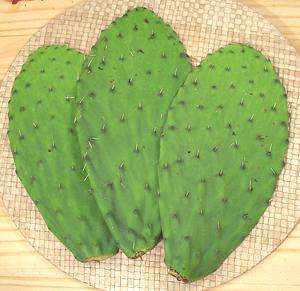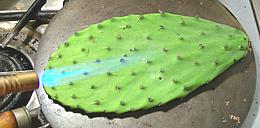
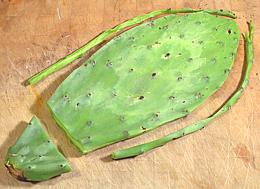
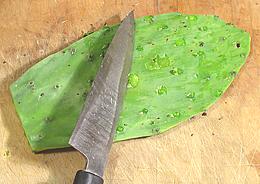
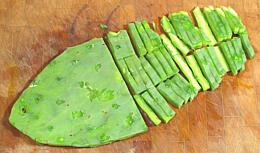
Buying and Storing
In the US Southwest fresh nopales are available in produce markets, generally in two forms: whole pads (nasty spines and all) and pads prepared and cut into short strips. In other parts of the country these strips are available canned, and will work in recipes.Buy whole pads that are bright green and between 8 and 12 inches long. Really small pads will cook to mush and larger pads that have turned blue-green have tough skins and may be fibrous. Whole pads will keep, wrapped in the refrigerator, for a couple weeks as they are still fully alive. At room temperature they will lose water and start to shrivel.
Bags of cut strips should be refrigerated if kept for more than a day, and used within a couple days.
Outside the Southwest US, Mexico and Central America you'll probably have to buy canned strips, but these should work OK as the canning process is similar to the short boiling used to prepare strips for recipes.
Preparation
- Use your Propane Blowtorch to burn off the sharp spines so you can handle the pads without pain. This works best torching from the tip end.
- Trim off the thick stem end, and optionally the edges.
- With the back edge of your kitchen knife scrape the surface to remove spine roots and any remaining bits of spines. Use the point to cut out any that won't remove and any imperfections. Rinse and wipe well.
- Cut into the desired shape. Most common is 3/8 x 3/8 inch square strips between 1 and 2 inches long.
- To prepare for use in a recipe, bring well salted water to a boil, stir in nopales and cook until tender but still crisp - 5 to 7 minutes for 3/8 x 3/8 inch strips.
Cochineal Insects
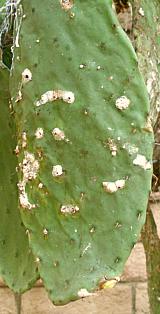 If you have your own prickly pear cactus and they have little cotton-like
puffs on the pads, they are infected with cochineal insects
(Dactylopius coccus) which will eventually kill them if not
treated. You can confirm this by scratching a few puffs and observe the
bright red stain that results.
If you have your own prickly pear cactus and they have little cotton-like
puffs on the pads, they are infected with cochineal insects
(Dactylopius coccus) which will eventually kill them if not
treated. You can confirm this by scratching a few puffs and observe the
bright red stain that results.
The female cochineal insects exude carminic acid dye which is gathered by scraping off the insects and crushing them. This was the dye used to make the British Redcoats coats red, but today it is used as a natural food coloring (carmine, cochineal extract, natural red #4), and in lipstick and other cosmetics.
Presuming you don't want to start a dye factory, small infestations
can be handled by scraping the insects off the pads. For larger
infestations spray a normal dilution of malathion with some dish washing
detergent added to assure the spray penetrates to the insects.
